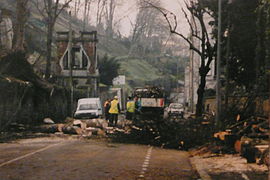Cyclone Lothar and Martin

Track of the central low pressure of Lothar
|
|
| Type |
European windstorm Extratropical cyclone |
|---|---|
| Formed | 25 December 1999 |
| Dissipated | 27 December 1999 |
| Lowest pressure | 960 mb (28 inHg) |
| Highest gust | 259 km/h (161 mph) |
| Areas affected | Western Europe |

Clearing damage in Angoulême 28 December 1999
|
|
| Formed | 26 December 1999 |
|---|---|
| Dissipated | 28 December 1999 |
| Lowest pressure | 963 mb (28.4 inHg) |
| Highest gust | 200 km/h (120 mph) |
| Areas affected | Western Europe |
Lothar and Martin were violent European windstorms which swept across western and central Europe during a period of 36 hours in December 1999. The storms caused major damage in France, southern Germany, Switzerland, and Italy. Throughout the affected region, 140 people were killed and damage was estimated at €9.9 billion. Both of these storms were associated with an intense jet stream aloft and benefitted from latent heat release through atmosphere-ocean exchange processes. Lothar and Martin together left 3.4 million customers in France without electricity, and forced EdF to acquire all the available portable power generators in Europe, with some even being brought in from Canada. These storms brought down a quarter of France's high-tension transmission lines and 300 high-voltage transmission pylons were toppled. It was one of the greatest energy disruptions ever experienced by a modern developed country.
December 1999 saw a series of heavy winter storms cross the North Atlantic and western Europe. In early December, Great Britain and Denmark were hit by Cyclone Anatol which caused severe damage in Denmark. A second storm then crossed Europe on 12 December. A very deep and sizeable depression moved across Britain on the night of 24–25 December (analysed to have possibly reached a low of 938 mb between Scotland and Norway), this set up a large area of westerly flow into Europe which brought Lothar. This highly unstable situation inevitably meant low predictability, and saw an unusually straight and strong jet stream (similar circumstances were also noted the day before the arrival of the Great Storm of 1987). Storm Martin then struck France and central Europe from 26 to 28 December 1999. At the end of January 2000 two additional damaging storms crossed Denmark and the northern part of Germany.
Windstorm Lothar was not well predicted, with one meteorologist later claiming that forecasts could be split into those that were poor and those that were very poor. According to some forecasts, the storm was predicted to pass through the United Kingdom, while others failed to predict significant intensification at all. The strong jet stream that was the chief cause of the instability was well predicted by the European Centre for Medium-Range Weather Forecasts 9 days earlier. Approximately 24 hours before the storm hit France, Météo-France issued a warning of a strong storm with the correct path, but two hours before the storm hit Paris, inland windspeeds were still predicted to be between 90–130 km/h (56-81 mph), rather than the 125–175 km/h (80-110 mph) range actually experienced.
...
Wikipedia
